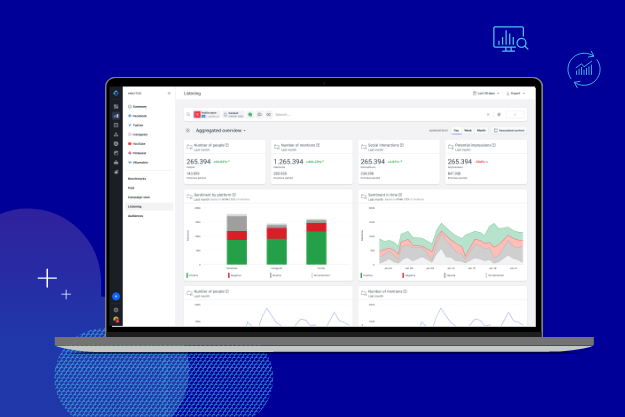With over 700 million users, LinkedIn is an indispensable platform for businesses to connect with both professionals and consumers across a wide spectrum of people. As the premier site for professional networking, LinkedIn transcends its role as a mere connection facilitator to become a vital marketing channel to reach customers — perfect for establishing a brand's presence and credibility.
Effective branding on LinkedIn requires more than random posts; it demands a consistent and strategic approach to content that resonates with both the platform's professionalism and the brand’s unique voice.
It’s worth exploring strategies to refine and maintain your company's brand tone — how your brand presents itself in language and approach — on LinkedIn, ensuring it aligns with your overall marketing objectives and effectively echoes with your target audience.

1. Leverage LinkedIn’s advanced publishing and networking tools
LinkedIn offers a suite of publishing and networking tools that can significantly enhance your brand’s visibility and authority.
For example, the platform’s publishing tool, LinkedIn Articles, allows thought leaders at your company to publish long-form content directly on LinkedIn. This can be used to explore complex topics, provide deep industry insights, or share comprehensive case studies that establish you and your brand as thought leaders. These articles also remain on your LinkedIn profile, serving as a permanent resource for potential clients and partners.
In addition to articles, LinkedIn Newsletters are a powerful tool for regular engagement. Subscribers receive updates directly in their inboxes, which not only increases the reach of your content but also keeps your audience engaged with your brand over time. This feature is particularly useful for launching series that delve into ongoing projects, track industry trends, or discuss key technology developments in depth.
Using LinkedIn’s networking tools effectively can also propel your brand forward. Actively participating in conversations within your network and engaging with content shared by others helps to raise your profile and can lead to higher content visibility. Regularly updating your company page with relevant content and timely news also keeps your network informed and engaged, reinforcing your presence on the platform.
2. Use interactive features and engage in Groups
Interactive features on LinkedIn, such as polls and surveys, offer brands a dynamic way to engage with their audience. These tools not only facilitate interaction with your audience but can also provide valuable insights into their preferences and opinions, sparking discussions while helping inform your future content strategies.
For example, you could prompt your followers and ask their opinion about certain product traits (like colors, sizes, price points, etc.) within your product spectrum, or even how they most like to engage with your brand.
Participation in LinkedIn Groups is another crucial strategy for enhancing engagement and establishing your brand’s authority. By joining groups relevant to your industry — or even creating your own — you can reach a targeted audience interested in specific topics. Share your insights, participate in discussions, and respond to queries to build credibility and trust within these communities. Hosting webinars or live discussions within these groups can also significantly increase your visibility and position your brand as a thought leader.
Creating exclusive content for group members, such as specialized articles or bespoke advice, can also foster a closer community feeling and encourage more personal engagement. This approach not only boosts your brand’s profile among industry peers but also enhances its reputation as a knowledgeable and reliable entity.
3. Drive engagement through valuable content
Content is the cornerstone of any LinkedIn strategy. Your content must not only inform but also inspire your audience to interact. High-quality, valuable content can be leveraged to encourage professional development and facilitate industry discussions, which are particularly appealing to audiences on LinkedIn.
Developing content that includes case studies, success stories, or user-generated content (UGC) can greatly boost interactions from your audience. These elements add a layer of credibility and relatability that purely informational content may lack. For example, showcasing how real clients have successfully implemented your solutions can help potential customers visualize their own success with your products, encouraging them to engage further with your brand.
4. Publish diverse content formats
Employing a variety of content formats is key to maintaining a dynamic and engaging LinkedIn presence. While articles and posts form the backbone of most LinkedIn content strategies, incorporating other formats like videos, infographics, and SlideShares can cater to your audience's diverse preferences and increase engagement.
Videos are particularly effective on LinkedIn. They can be used to share quick tips, industry insights, or even behind-the-scenes looks at your company, all of which can help humanize your brand and strengthen connections with your audience. Infographics, on the other hand, are excellent for distilling complex data into easily digestible visuals that catch the eye and are highly shareable.
SlideShares offers another unique avenue for content delivery. By converting presentations into SlideShare format, you can reach professionals who prefer detailed, point-by-point explorations of topics, and they’re ideal for sharing more in-depth insights that may be too lengthy for a standard post or article.
Also, incorporating interactive elements such as Q&A sessions, live talks, or panel discussions into your content strategy can further increase engagement. These formats not only allow for real-time interaction but also give your audience a platform to voice their concerns and get immediate responses, making your brand more approachable and responsive.
Takeaway: Striking the right brand tone on LinkedIn is key
Thoughtfully integrating these varied content types into your LinkedIn strategy not only keeps your feed fresh but also maintains a brand tone that will position you well for consistent engagement on the platform, catering to different user preferences and maximizing the impact of your content.
LinkedIn is a unique platform for brands, and the expectations of its users are different from those anywhere else in the social media landscape. Keeping that in mind will help ensure your tone is appropriate for the audience you’ll find there.







































